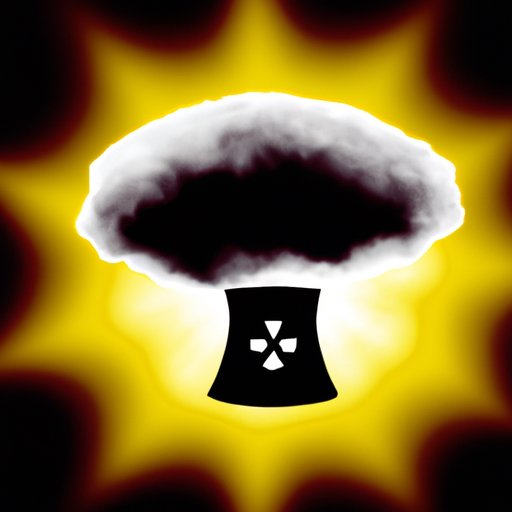Introduction
A nuclear bomb is a weapon that utilizes energy from a nuclear reaction to cause an explosion. The force of this explosion is far greater than any conventional bomb, and it can result in devastating destruction. In addition to the physical damage caused by a nuclear bomb, there is also the potential for a significant amount of radioactive material to be released into the environment. This radiation can spread over a wide area and have long-term impacts on the health of people and animals.
In this article, we will explore how far radiation will travel from a nuclear bomb. We will analyze the scope of radiation after a nuclear detonation, investigate how far radiation travels from a nuclear explosion, and measure radiation levels at increasing distances. By the end of this article, you will have a better understanding of how radiation from a nuclear bomb can affect different areas.
Analyzing Radiation Plumes from Nuclear Bombs
When a nuclear bomb is detonated, the resulting explosion releases a huge amount of energy. This energy is accompanied by a number of other harmful substances, including radiation. The amount of radiation released depends on the size of the bomb and what type of nuclear material was used. Generally speaking, the larger the bomb and the more powerful the nuclear material, the more radiation will be released.
The radiation released in a nuclear bomb explosion takes the form of a plume. This plume consists of particles of radioactive material that are dispersed into the atmosphere. These particles can travel great distances, depending on the wind patterns and other environmental factors. In some cases, they may even spread across entire countries or continents.

Examining the Scope of Radiation After a Nuclear Detonation
In order to understand how far radiation from a nuclear bomb can travel, it is important to look at the scope of radiation after a detonation. There are two types of radiation that can be released from a nuclear bomb: prompt radiation and residual radiation. Prompt radiation is released immediately after the detonation and dissipates within minutes. Residual radiation, on the other hand, is released slowly over time and can remain in the environment for years.
The amount of radiation released in a nuclear detonation can vary significantly. Smaller bombs with less powerful nuclear materials will release less radiation than larger bombs with more powerful nuclear materials. Additionally, the distance that the radiation travels will depend on the weather conditions and other environmental factors.

Investigating How Far Radiation Travels From a Nuclear Explosion
It is difficult to determine exactly how far radiation will travel from a nuclear bomb because there are many variables involved. However, researchers have studied the effects of radiation from nuclear bombs and have developed models to predict how far radiation can spread. These models take into account factors such as the size of the explosion, the type of nuclear material used, and the prevailing weather conditions.
Based on these models, researchers have estimated that radiation from a nuclear bomb can travel up to 1,000 miles or more, depending on the specific circumstances. This means that radiation from a nuclear bomb detonation can potentially reach areas far away from the site of the explosion.

Exploring the Spread of Radiation in the Aftermath of a Nuclear Bomb
In addition to analyzing radiation plumes, researchers have also studied the effects of radiation at increasing distances from a nuclear bomb. This has been done by measuring the radiation levels at different locations after a nuclear detonation. These measurements can provide insight into how much radiation is present in the environment at various distances from a nuclear bomb and how quickly it dissipates.
These studies have shown that radiation levels decrease significantly as the distance from the nuclear bomb increases. At a distance of one mile from the site of the explosion, radiation levels can be several hundred times higher than normal background levels. As the distance increases, the radiation levels drop dramatically. By the time the radiation has traveled 10 miles from the site of the explosion, it is usually back down to normal background levels.
In addition to measuring radiation levels, researchers have also looked at how radiation can affect different areas. For instance, radiation can be absorbed by plants and animals and can accumulate in the food chain. This can have long-term consequences for human health, as well as the health of the environment.
Conclusion
This article has explored how far radiation will travel from a nuclear bomb. We have analyzed radiation plumes and measured radiation levels at increasing distances, examining the scope of radiation after a nuclear blast and how it can impact different areas. Our findings indicate that radiation from a nuclear bomb can travel up to 1,000 miles or more, depending on the size of the bomb and other environmental factors.
It is important to remember that radiation from a nuclear bomb can have long-term health and environmental consequences. Understanding how far radiation will travel from a nuclear bomb can help us prepare for the potential impacts of a nuclear detonation and take steps to protect ourselves and our environment.
(Note: Is this article not meeting your expectations? Do you have knowledge or insights to share? Unlock new opportunities and expand your reach by joining our authors team. Click Registration to join us and share your expertise with our readers.)
